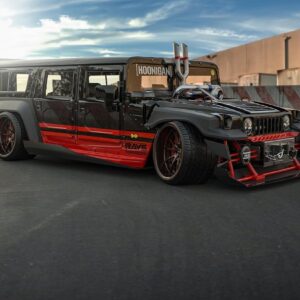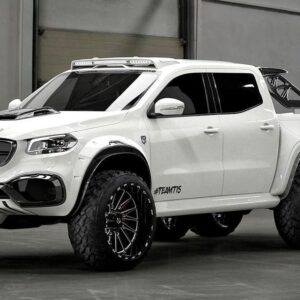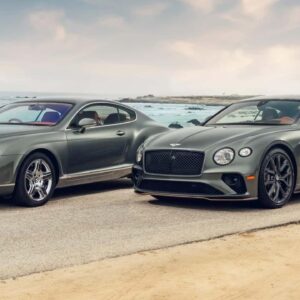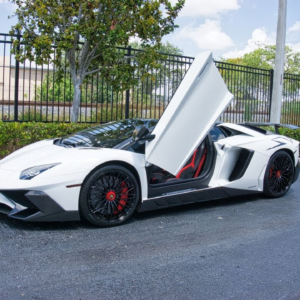From the April 2000 issue of Car and Driver.
Have we got a deal for you: Write out a nice check for $100,300 and send it to the British manufacturer of this beauty, and he’ll send you the car all wrapped in a big shipping box—only there’s no engine.
We hear you right now saying, “Great. That’s worse than those $75,000 Mustangs.”
Wait, don’t throw the magazine across the room—you’re not going to believe this. After you’ve invested, oh, another $40,000 or so for an engine and transmission, you’re going to own a car that is quicker than the latest Porsche Turbo, any showroom Ferrari, even the fearsome Dodge Viper. To be fair, unlike the other cars, which are real cars, this British import is more a race car tuned for the streets since there are no airbags and there’s minuscule luggage space and it’s tricky to get into.
The car, called the Ultima GTR, hails from the fertile race-car turf of Britain, the land where McLaren, Reynard, Williams, and Van Diemen build race cars that win with remarkable regularity. Lee Noble, a freelance car designer, designed and built the first Ultima in 1983 for a British kit-car racing series. It used many Renault parts, including a 270-horsepower V-6 engine mounted amidships. It was a success at the track, so Noble went on to sell 40 race cars before 1988, when he updated it. One of the 13 new models was purchased for about $25,000 by a civil engineer named Ted Marlow.
A weekend racer, Marlow did what most race-car owners do—he customized the Ultima to his liking. He swapped the V-6 for a 440-hp Chevy small-block V-8. In 1992, after four years of modifying and perfecting his car, Marlow, then 44, purchased Noble’s enterprise. His goal was to turn the Ultima into a civilized street car yet retain its prowess on the track. The project took 18 months. Marlow replaced the Renault parts with Ultima-specific units. He farmed out some bits and pieces but did most of the work himself. The brakes, for example, were designed by the well-known firm AP Racing.
Since 1995, Marlow’s small factory in Hinckley, England, has turned out about 200 Ultimas. And this year, in faraway California, a retired marketing executive named Mike Mullin has begun selling Ultima GTRs from his Costa Mesa shop.
As an engineless kit car, the Ultima bypasses federal regulations. Once it’s in the States, Mullin will install whatever engine you wish to pay for, but currently, he has two options—an aftermarket small-block Chevy V-8 or a current-production LS1 V-8 from a C5 Corvette. Both engines use a late-model Porsche 911 transmission and differential. The small-block engine and the 911 transaxle cost $38,000; the LS1 engine with transaxle costs $42,000.
If, however, you live in a state with strict emissions laws and annual smog tests—California, for one—you need the LS1 V-8. The beauty of its installation is that the stock engine-control system, the catalysts, and the OBD II diagnostics remain unchanged.
The LS1 engine in the car we tested felt perfect. Pumping out 345 hp, the aluminum V-8 is a proven, trouble-free, instantly responding gem. Our Ultima GTR weighed just 2314 pounds, so the Vette engine practically lifts the front wheels off the ground at full throttle. Zero to 60 mph flashes by in 3.3 seconds. It’ll hit 100 mph in 8.4 seconds, and that’s quicker than any current production car we’ve tested—it even outruns Warren Mosler’s Raptor, the other street-legal Group C wannabe. (But remember that the nearly $160,000 Raptor has passed federal crash standards, a feat the Ultima GTR has not attempted since it is, technically, a kit car.) At more than 150 mph, which comes in 26.3 seconds from standstill, the Ultima’s high-drag shape and optional $3700 rear wing slow things down a bit, but nonetheless, the 157-mph top speed occurs at the 6000-rpm redline in fifth gear. The car felt solid and didn’t play sensitive even once during our tough performance testing. And, there’s a 12-month warranty.
There is nothing kit-carish about it in reality. Most kit cars borrow heavily from existing vehicles. Not so with the GTR. Other than the engine, transmission, and lights, it’s virtually all original.
In England, race shops dot the countryside, and it’s apparent that skilled fabricators with talented hands have turned out this car. The fiberglass body of our test car had not a ripple across its curvy flanks. Every weld of the steel-tube frame displayed nearly perfect beads. The doors didn’t hint of binding, and the interior displayed impeccable fit and finish.
The Ultima’s suspension employs unequal-length control arms all around and big vented, cross-drilled disc brakes that performed without fade. We experienced some early rear lockup that lengthened the stopping distance from 70 to 0 mph to 199 feet, but Mullin said some brake tuning would shorten that distance quite a bit. Considering how well the car hooked up under acceleration and the excellent 0.98-g lateral-acceleration figure, we know the Ultima has plenty of grip.
Scorching performance is all well and good on the track. The real test comes on public roads, and that’s where the Ultima really surprised us.
The ride is certainly firm, and yes, we did drive the car on smooth California roads. But even when we could see a nasty patch of road ahead and braced ourselves for some kidney upset, the unpleasantness never came. On the highway, the Ultima didn’t wander a bit. Since Mullin retained the cats and muffler that come with the LS1 engine, the loudest noise we heard was some wind roar. Overall, the ride is acceptable and nonpunishing. The low ride height made us fear driveway ramps and parking lots, but the short overhangs prevented the front end from scraping.
We wouldn’t call the Ultima GTR a grocery getter, simply because it’s a bit difficult to get into and out of. You won’t need a gymnast’s license to obtain entry, but the wide, tall sill and the low seat will give pause to consider how you’re going to get in. Our test car came with the optional $2050 safety cage, which provided some handholds for entry. Once in, you’re blessed with a low, snail’s-eye view of the road, a small steering wheel, a metal shifter emerging directly from the floor, and room for anyone as long as they are not much taller than six feet two. The interior is refreshingly simple, with five plain white gauges logically placed. The climate controls are another matter, however, since they’re under the dash and require memorization to use. Despite the large glass area, the $3100 optional A/C worked well, as did the heater (another $1000).
For kicks, we took a few laps on a racetrack and couldn’t believe how confident the Ultima GTR made us feel. It is simply a well-engineered and well-built car. In every corner, straight, and braking zone, our test car was rock solid, with absolutely no twitchiness despite our prodigious speeds. We could gush on forever, but the bottom line is we’d sacrifice plenty for a day of track time in the GTR.
At $152,150, there are numerous cars that’ll give you a thrill, but we have to put the Ultima GTR in with the top five cars that push all the right auto-enthusiast buttons. As of this writing, it’s been two months since we drove it, and we’re still smiling.
Specifications
Specifications
2000 Ultima GTRVehicle Type: mid-engine, rear-wheel-drive, 2-passenger, 2-door coupe
PRICE Base/As Tested: $138,300/$152,150
ENGINEpushrod 16-valve V-8, aluminum block and heads, port fuel injection Displacement: 346 in3, 5663 cm3 Power: 345 hp @ 5600 rpm Torque: 350 lb-ft @ 4400 rpm
TRANSMISSION5-speed manual
DIMENSIONS Wheelbase: 100.0 in Length: 162.0 inCurb Weight: 2314 lb
C/D TEST RESULTS 60 mph: 3.3 sec 100 mph: 8.4 sec 1/4-Mile: 11.9 sec @ 117 mph 150 mph: 26.3 sec Rolling Start, 5–60 mph: 3.9 sec Top Speed (redline ltd): 157 mphBraking, 70–0 mph: 199 ft Roadholding, 300-ft Skidpad: 0.98 g
C/D TESTING EXPLAINED
 View Photos
View Photos View PhotosJEFFREY G. RUSSELL|Car and Driver
View PhotosJEFFREY G. RUSSELL|Car and Driver
 View PhotosJEFFREY G. RUSSELL|Car and Driver
View PhotosJEFFREY G. RUSSELL|Car and Driver
 View PhotosJEFFREY G. RUSSELL|Car and Driver
View PhotosJEFFREY G. RUSSELL|Car and Driver





